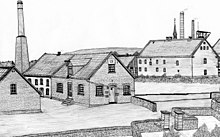Rodenberg moated castle
The House Rodenberg is a moated castle in the Dortmund area Aplerbeck . The castle fell into disrepair in the 19th and 20th centuries. All that remained of the former moated castle was the outer bailey with the business section.
history
The Rodenberg house was first mentioned in a document in 1290. At that time it was inhabited by Ritter Diederich von dem Rodenberg.
After the castle was destroyed in the Clevisch-Märkischen succession dispute in 1422, it was rebuilt in the following years by Hermann von Voss zum Rodenberg with an attached residential tower. Between 1689 and 1698 the castle was converted into a baroque moated castle. As a result, it came to the Vogt of Elspe . Katharina Sophia Luisa Theodora Vogt von Elspe brought the castle to her husband Gisbert Wilhelm von Bodelschwingh , the owner of the neighboring Bodelschwingh house, in 1728 . Their only child together, the heiress Gisbertine Anna Luise von Bodelschwingh, married Mathias von Bodelschwingh-Velmede for the second time and had the daughter Christine Sophie Luise with him. House Bodelschwingh and House Rodenberg brought this to her husband, Karl Wilhelm Georg von Plettenberg - Heeren , who took the name Bodelschwingh-Plettenberg after his marriage in 1805. His grandson, Count Carl Gisbert Wilhelm von Bodelschwingh-Plettenberg inherited the extensive family property in 1907 to his only child, Wilhelmine, who married Baron Dodo Alexander zu Innhausen and Knyphausen (* 1835 - † 1911), who then also took the title of Count von Bodelschwingh- Plettenberg led. His son Karl Moritz Freiherr zu Innhausen and Knyphausen, Count von Bodelschwingh-Plettenberg (* 1871, † 1958), was entrant on Bodelschwingh and master on Rodenberg. While his son, Count Edzard (* 1905) inherited Haus Bodelschwingh, Haus Rodenberg fell to their daughter Elma Freiin zu Innhausen and Knyphausen (1919-2004), who was married to Udo von Alvensleben . In 1985, the latter sold the property to the city of Dortmund, which had Park and House Rodenberg completely restored by 1996 and finally handed it over to the citizens of Dortmund. The castle is listed as an architectural monument , the former castle as a ground monument in the list of monuments of the city of Dortmund .
Today the house Rodenberg is home to seminar rooms of the adult education center Dortmund , the fairytale stage (a puppet theater for children and adults) as well as upscale gastronomy. The premises of Haus Rodenberg can be rented for so-called ambience weddings through the Volkshochschule Dortmund. The former mill pond and the park with "orchard" are well visited in summer.
See also
literature
- Hans Georg Kirchhoff, Siegfried Liesenberg: 1100 years of Aplerbeck, 899–1999. Festschrift. Klartext Verlag, Essen 1998, ISBN 3-88474-735-5 .
Web links
- Records of the document holdings for the Rodenberg house from the Bodelschwingh archive / digital Westphalian document database (DWUD)
- History of the Rodenberg house
- Von Voss family on Rodenberg
- The fairytale stage
- August 2010 - ... "a beautiful and funny knight seat". Mighty sandstone walls discovered during the renaturation of the Emscher at Haus Rodenberg. In: dortmund.de - The Dortmund city portal. Monument authority of the city of Dortmund, accessed on June 11, 2014 .
- 360 ° panorama picture of the moated castle Haus Rodenberg in the Kulturatlas Westfalen (requires Flash-Player )
Individual evidence
- ↑ No. A 0233 and B 0012. List of monuments of the city of Dortmund. (PDF) (No longer available online.) In: dortmund.de - Das Dortmunder Stadtportal. Monument Authority of the City of Dortmund, April 14, 2014, archived from the original on September 15, 2014 ; accessed on June 11, 2014 (size: 180 kB).
Coordinates: 51 ° 29 ′ 34.2 ″ N , 7 ° 33 ′ 15 ″ E





